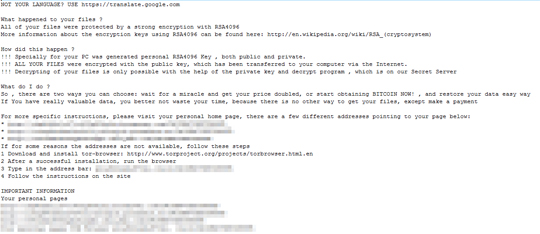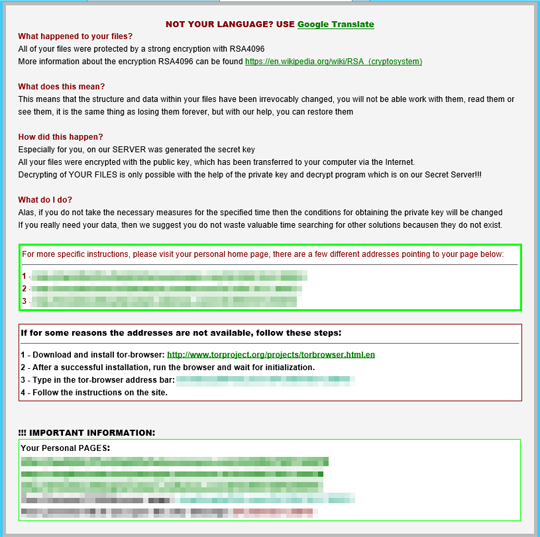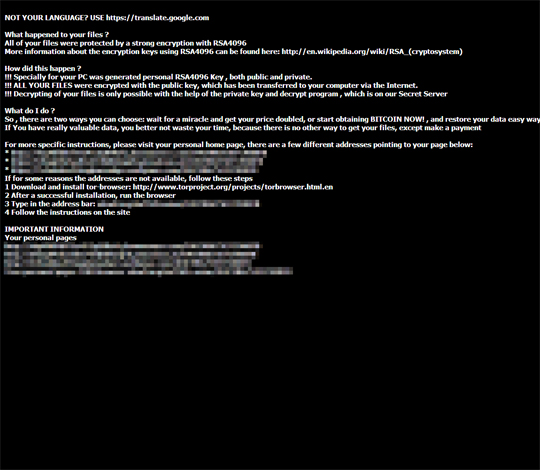RANSOM_CRYPTESLA.YUYAJC
Windows


Threat Type: Trojan
Destructiveness: No
Encrypted: Yes
In the wild: Yes
OVERVIEW
Downloaded from the Internet, Dropped by other malware
This Trojan arrives on a system as a file dropped by other malware or as a file downloaded unknowingly by users when visiting malicious sites.
It modifies the Internet Explorer Zone Settings.
It connects to certain websites to send and receive information. It deletes the initially executed copy of itself. It gathers information and reports it to its servers.
TECHNICAL DETAILS
483,328 bytes
EXE
No
09 Mar 2016
Corrupts hard disk, Encrypts files, Connects to URLs/IPs, Steals information
Arrival Details
This Trojan arrives on a system as a file dropped by other malware or as a file downloaded unknowingly by users when visiting malicious sites.
Installation
This Trojan drops the following copies of itself into the affected system and executes them:
- %Windows%\{random filename}.exe (with Administrator Privileges)
- %My Documents%\{random filename}.exe (with non-Administrator Privileges)
(Note: %My Documents% is C:\Users\{user name}\Documents on Windows Vista and above.)
(Note: %Windows% is the Windows folder, where it usually is C:\Windows on all Windows operating system versions.)
It drops the following files:
- %My Documents%\recover_file_{random characters}.txt
- Ransom Notes:
- %Desktop%\_ReCoVeRy_.HTM
- %Desktop%\_ReCoVeRy_.png
- %Desktop%\_ReCoVeRy_.TXT
- %User Profile%\_ReCoVeRy_+{random characters}.html
- %User Profile%\_ReCoVeRy_+{random characters}.png
- %User Profile%\_ReCoVeRy_+{random characters}.txt
- {Folders containing encrypted files}\_ReCoVeRy_+{random characters}.html
- {Folders containing encrypted files}\_ReCoVeRy_+{random characters}.png
- {Folders containing encrypted files}\_ReCoVeRy_+{random characters}.txt
(Note: %User Profile% is the current user's profile folder, which is usually C:\Documents and Settings\{user name} on Windows 2000, XP, and Server 2003, or C:\Users\{user name} on Windows Vista and 7.)
Autostart Technique
This Trojan creates the following registry entries to enable automatic execution of dropped component at every system startup:
HKEY_CURRENT_USER\Software\Microsoft\
Windows\CurrentVersion\Run
{4 random characters}-{8 random characters} = "%Windows%\{random filename}.exe" (with Administrator Privileges)
HKEY_CURRENT_USER\Software\Microsoft\
Windows\CurrentVersion\Run
{4 random characters}-{8 random characters} = "%My Documents%\{random filename}.exe" (with non-Administrator Privileges)
Other System Modifications
This Trojan modifies the following file(s):
- It encrypts files and appends the extension .mp3 to them
It adds the following registry keys:
HKEY_CURRENT_USER\Software\zzzsys
HKEY_CURRENT_USER\Software\{Installation ID}
It adds the following registry entries as part of its installation routine:
HKEY_CURRENT_USER\Software\zzzsys
ID = {Installation ID}
Web Browser Home Page and Search Page Modification
This Trojan modifies the Internet Explorer Zone Settings.
Other Details
This Trojan connects to the following website to send and receive information:
- http://{BLOCKED}edicalcentre.com/wp-content/uploads/wstr.php
- http://{BLOCKED}lizedaccess.co.uk/wp-content/uploads/2015/09/wstr.php
- http://{BLOCKED}stitut.org/wp-content/themes/bstr.php
- http://www.{BLOCKED}aticauno.net/gamma/tmp/bstr.php
- http://www.{BLOCKED}aticauno.net/gamma/tmp/wstr.php
- http://{BLOCKED}our.info/users/28c4fe1/wstr.php
It encrypts files with the following extensions:
- .lvl
- .arch00
- .ntl
- .fsh
- .itdb
- .itl
- .mddata
- .sidd
- .sidn
- .bkf
- .qic
- .bkp
- .bc7
- .bc6
- .pkpass
- .tax
- .gdb
- .qdf
- .t12
- .t13
- .ibank
- .sum
- .sie
- .zip
- .w3x
- .rim
- .psk
- .tor
- .vpk
- .iwd
- .mlx
- .fpk
- .dazip
- .vtf
- .vcf
- .esm
- .blob
- .dmp
- .layout
- .menu
- .kf
- .ncf
- .sid
- .sis
- .ztmp
- .vdf
- .mov
- .fos
- .itm
- .wmo
- .itm
- .map
- .wmo
- .svg
- .cas
- .gho
- .syncdb
- .hkdb
- .hplg
- .hvpl
- .icxs
- .docm
- .wps
- .xls
- .xlsx
- .xlsm
- .xlsb
- .xlk
- .ppt
- .pptx
- .pptm
- .mdb
- .accdb
- .pst
- .dwg
- .dxg
- .wpd
- .rtf
- .wb2
- .pfx
- .p12
- .p7b
- .sb
- .mdbackup
- .xf
- .p7c
- .txt
- .jpeg
- .png
- .css
- .flv
- .m3u
- .desc
- .xxx
- wallet
- .big
- .pak
- .rgss3a
- .epk
- .bik
- .slm
- .lbf
- .sav
- .re4
- .apk
- .bsa
- .ltx
- .forge
- .asset
- .iwi
- .das
- .upk
- .d3dbsp
- .csv
- .wmv
- .avi
- .wma
- .m4a
- .rar
- .mp4
- .sql
- .bak
- .tiff
- .com
- .py
- .js
- .rb
- .litesql
- .litemod
- .7z
- .x3f
- .der
- .cer
- .crt
- .pem
- .odt
- .ods
- .odp
- .odm
- .odc
- .odb
- .doc
- .docx
It deletes the initially executed copy of itself
It gathers the following information and reports it to its servers:
- IP address
- OS version
- installation id (inst_id)
- ID value from the registry HKEY_CURRENT_USER\Software\zzzsys
NOTES:
This malware encrypts files in all fixed, removable, and network drives and shares.
It executes the following command to delete shadow copies:
"C:\Windows\System32\wbem\WMIC.exe" shadowcopy delete /nointeractive
It opens the following ransom notes after encryption:



SOLUTION
9.800
12.392.09
09 Mar 2016
12.393.00
10 Mar 2016
Step 1
Before doing any scans, Windows XP, Windows Vista, and Windows 7 users must disable System Restore to allow full scanning of their computers.
Step 2
Note that not all files, folders, and registry keys and entries are installed on your computer during this malware's/spyware's/grayware's execution. This may be due to incomplete installation or other operating system conditions. If you do not find the same files/folders/registry information, please proceed to the next step.
Step 3
Scan your computer with your Trend Micro product and note files detected as RANSOM_CRYPTESLA.YUYAJC
Step 4
Restart in Safe Mode
Step 5
Delete this registry value
Important: Editing the Windows Registry incorrectly can lead to irreversible system malfunction. Please do this step only if you know how or you can ask assistance from your system administrator. Else, check this Microsoft article first before modifying your computer's registry.
- In HKEY_CURRENT_USER\Software\Microsoft\Windows\CurrentVersion\Run
- {4 random characters}-{8 random characters} = "%Windows%\{random filename}.exe" (with Administrator Privileges)
- {4 random characters}-{8 random characters} = "%Windows%\{random filename}.exe" (with Administrator Privileges)
- In HKEY_CURRENT_USER\Software\Microsoft\Windows\CurrentVersion\Run
- {4 random characters}-{8 random characters} = "%My Documents%\{random filename}.exe" (with non-Administrator Privileges)
- {4 random characters}-{8 random characters} = "%My Documents%\{random filename}.exe" (with non-Administrator Privileges)
Step 6
Delete this registry key
Important: Editing the Windows Registry incorrectly can lead to irreversible system malfunction. Please do this step only if you know how or you can ask assistance from your system administrator. Else, check this Microsoft article first before modifying your computer's registry. Before you could do this, you must restart in Safe Mode. For instructions on how to do this, you may refer to this page If the preceding step requires you to restart in safe mode, you may proceed to edit the system registry.
- In HKEY_CURRENT_USER\Software
- zzzsys
- zzzsys
- In HKEY_CURRENT_USER\Software
- {Installation ID}
- {Installation ID}
Step 7
Restart in normal mode and scan your computer with your Trend Micro product for files detected as RANSOM_CRYPTESLA.YUYAJC. If the detected files have already been cleaned, deleted, or quarantined by your Trend Micro product, no further step is required. You may opt to simply delete the quarantined files. Please check this Knowledge Base page for more information.
Step 8
Restore encrypted files from backup.
Did this description help? Tell us how we did.


